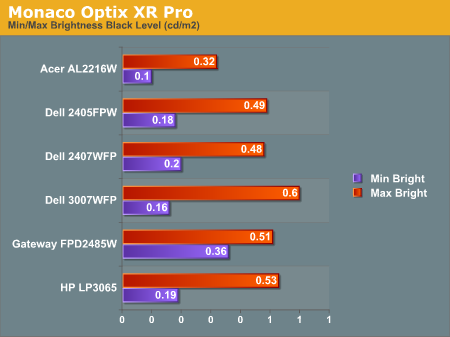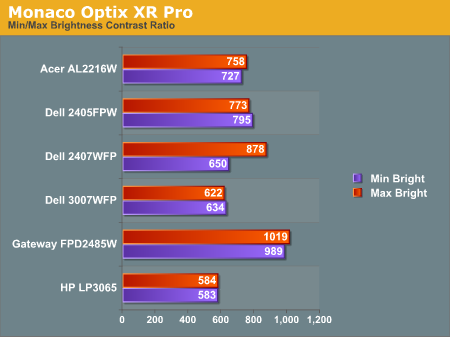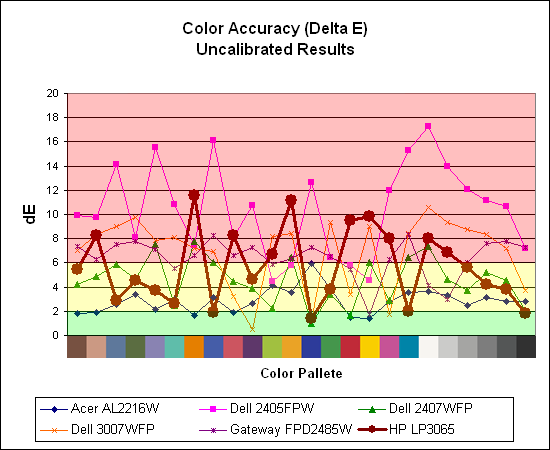HP LP3065: A new contender for the 30" throne
by Jarred Walton on March 22, 2007 7:00 AM EST- Posted in
- Displays
Uncalibrated Results
Brightness and Contrast Ratio
For these tests more than any others, we depend on the hardware colorimeter and software to help calibrate the displays. As previously stated, we use a Monaco Optix XR (DTP-94) colorimeter and Monaco Optix XR Pro software. The software and hardware are relatively easy to use and help users to get more accurate color from their displays. Before we get to the calibrated results, we took a quick look at how the displays performed at maximum brightness as well as how they fared without any color profile. We used the default contrast and color settings for all the displays, with the brightness level adjusted according to various "easy calibration" charts.



All three of the Dell LCDs are relatively consistent in terms of brightness levels and contrast ratios. The Gateway FPD2485W on the other hand is clearly brighter than the other LCDs, and it also has a higher contrast ratio. It's interesting to note that the HP LP3065 actually doesn't have as bright of a backlight as the older Dell 3007WFP, and in fact the 3007WFPHC also lists a slightly lower maximum brightness. The HP display also has a lower contrast ratio - the "worst" of the bunch in fact. As we mentioned in the Gateway review, however, looking at these numbers really doesn't tell you a whole lot about how a display really performs. In the case of the Gateway LCD, even at minimum brightness it can feel overly bright in some environments.
Color Accuracy
The problem with calibrating a display is that it doesn't help all applications. Specifically, the video overlay used when watching DVDs or other movies completely bypasses any color profiles, so you are essentially stuck with the uncalibrated colors. It is possible to tweak things slightly on some LCDs using the OSD, but the amount of color correction that can be done via the OSD pales in comparison to color correction tables, and LCDs like the Dell 3007WFP and HP LP3065 are unable to adjust anything but brightness outside of software. Ideally, we would like to see video drivers begin to apply color profiles to the overlay output as well, but we're not sure how much work that would require - or if it's even possible.
For uncalibrated color accuracy, we adjusted the brightness and contrast (where applicable) using a "calibrate by eye" chart. Also remember that color accuracy can vary from penalty panel even within the same model, and the results we are reporting are only from looking at a single LCD. We ended up using 91% brightness (nine steps down from maximum brightness) on the HP LCD.
During testing, Monaco Optix XR Pro sends 24 color patches to the display with the colorimeter measuring the resulting values. The difference between what is requested and what the LCD actually shows is known as Delta E, with lower values being better. Any score less than one is basically "perfect" - the naked eye is not going to be able to tell the difference - and scores less than 2.0 are very nearly perfect. Ideally, you would want all of the tested colors to have a Delta E of less than 1.0, but almost no one is likely to have problems with anything scoring below 2.0. From 2.0 to 4.0, most people still won't notice the slight inaccuracies in the color palette, but when comparing displays side by side differences may be apparent - multimedia professionals would prefer something better. Anything above 4.0 begins to represent a more significant deviance, and numerous scores above 6.0 will almost certainly be noticeable by just about anyone using the display.


Without any form of color correction, the color accuracy of all of these displays is generally mediocre, with one exception. The Acer AL2216W generates a Delta E result of 2.88 using the default settings with a contrast ratio of 88 and a brightness level of 72. While 2.88 certainly isn't "perfect", it's far better than any other LCD we have reviewed so far. How bad are the colors on the other displays though? As we have said before, the human eye is very good at adapting, and while we definitely notice the transition that occurs when our color profile is loaded, it would take a lot more work to actually sit down at a display and determine whether or not the colors are "good". Even the Dell 2405FPW with an extremely high uncalibrated Delta E still doesn't bother us, but then we aren't imaging professionals.
We should also note that fluctuations of as much as one point in Delta E are possible during a short amount of time. It generally takes as much as 30 minutes for a monitor to "warm up" after it's first powered on, and all of our calibration and testing is performed after the displays have been running for at least one hour with their screensavers disabled.
Brightness and Contrast Ratio
For these tests more than any others, we depend on the hardware colorimeter and software to help calibrate the displays. As previously stated, we use a Monaco Optix XR (DTP-94) colorimeter and Monaco Optix XR Pro software. The software and hardware are relatively easy to use and help users to get more accurate color from their displays. Before we get to the calibrated results, we took a quick look at how the displays performed at maximum brightness as well as how they fared without any color profile. We used the default contrast and color settings for all the displays, with the brightness level adjusted according to various "easy calibration" charts.



All three of the Dell LCDs are relatively consistent in terms of brightness levels and contrast ratios. The Gateway FPD2485W on the other hand is clearly brighter than the other LCDs, and it also has a higher contrast ratio. It's interesting to note that the HP LP3065 actually doesn't have as bright of a backlight as the older Dell 3007WFP, and in fact the 3007WFPHC also lists a slightly lower maximum brightness. The HP display also has a lower contrast ratio - the "worst" of the bunch in fact. As we mentioned in the Gateway review, however, looking at these numbers really doesn't tell you a whole lot about how a display really performs. In the case of the Gateway LCD, even at minimum brightness it can feel overly bright in some environments.
Color Accuracy
The problem with calibrating a display is that it doesn't help all applications. Specifically, the video overlay used when watching DVDs or other movies completely bypasses any color profiles, so you are essentially stuck with the uncalibrated colors. It is possible to tweak things slightly on some LCDs using the OSD, but the amount of color correction that can be done via the OSD pales in comparison to color correction tables, and LCDs like the Dell 3007WFP and HP LP3065 are unable to adjust anything but brightness outside of software. Ideally, we would like to see video drivers begin to apply color profiles to the overlay output as well, but we're not sure how much work that would require - or if it's even possible.
For uncalibrated color accuracy, we adjusted the brightness and contrast (where applicable) using a "calibrate by eye" chart. Also remember that color accuracy can vary from penalty panel even within the same model, and the results we are reporting are only from looking at a single LCD. We ended up using 91% brightness (nine steps down from maximum brightness) on the HP LCD.
During testing, Monaco Optix XR Pro sends 24 color patches to the display with the colorimeter measuring the resulting values. The difference between what is requested and what the LCD actually shows is known as Delta E, with lower values being better. Any score less than one is basically "perfect" - the naked eye is not going to be able to tell the difference - and scores less than 2.0 are very nearly perfect. Ideally, you would want all of the tested colors to have a Delta E of less than 1.0, but almost no one is likely to have problems with anything scoring below 2.0. From 2.0 to 4.0, most people still won't notice the slight inaccuracies in the color palette, but when comparing displays side by side differences may be apparent - multimedia professionals would prefer something better. Anything above 4.0 begins to represent a more significant deviance, and numerous scores above 6.0 will almost certainly be noticeable by just about anyone using the display.


Without any form of color correction, the color accuracy of all of these displays is generally mediocre, with one exception. The Acer AL2216W generates a Delta E result of 2.88 using the default settings with a contrast ratio of 88 and a brightness level of 72. While 2.88 certainly isn't "perfect", it's far better than any other LCD we have reviewed so far. How bad are the colors on the other displays though? As we have said before, the human eye is very good at adapting, and while we definitely notice the transition that occurs when our color profile is loaded, it would take a lot more work to actually sit down at a display and determine whether or not the colors are "good". Even the Dell 2405FPW with an extremely high uncalibrated Delta E still doesn't bother us, but then we aren't imaging professionals.
We should also note that fluctuations of as much as one point in Delta E are possible during a short amount of time. It generally takes as much as 30 minutes for a monitor to "warm up" after it's first powered on, and all of our calibration and testing is performed after the displays have been running for at least one hour with their screensavers disabled.










44 Comments
View All Comments
JarredWalton - Thursday, March 22, 2007 - link
I tried to get one and Apple declined. I think Anand has their original version, but that has been outdated by newer releases. If Apple updates their 30" display again, I will see if they're interested in sending one for review.FXi - Thursday, March 22, 2007 - link
The brightness is too low. And the benefit (the wider gamut) is harder to gain the advantage of visually than losing the brightness. In fact it is likely the older 3007FP is a better screen in practical use than the 3007FPHC.I'm not talking TV levels here like 500-550 cd/m2, but rather that 400-450 wasn't bad, and as the backlights degrade slowly over time, effectively give a nice lifespan if you aren't using them in bright environments.
The cost of adding a few extra DVI-D inputs is so cheap it's a travesty they weren't included in every 30" model. PIP might be genuinely useful on a screen this size, so there's another area where the scaling and picture circuitry would be useful. In fact, skip the USB bus entirely and at least give me two, or three DVI-D ports instead.
Probably I missed how you approached it but I saw no direct mention of screen uniformity, which has been a bother in earlier 30" models.
I would add the Samsung 305T and XL30 (when it arrives) to show the full gamut of these size screens. A LOT of folks are commenting that the increased color gamut isn't all that noticeable or useful due partially to a lack of good standards on the pc side to utilize that gamut. 120hz is going to happen faster to smaller displays (sorry) because a DVI-D might have enough bandwidth to drive lower res at double the refresh. I'm not perfectly familiary with the overhead needs, but the bandwidth will be there first, not first in larger displays and moving down. This again points to the use of a 32" 1080P 120hz screen utilizing a card that had HDMI 1.3 output as your fastest way of getting to the 120hz goodness if that is what you seek. Otherwise you'll have to wait a few years.
Core things that need to happen to 30" in general:
400-450 brightness
OSD's
Scaling chips and alternate/multiple inputs
LED backlights (as practical - and not for the gamut increased but the better contrast ratio, screen uniformity and lifespan)
Faster and more consistent (better profiled acceleration) TrTf and GtG speeds
Color accuracy and grey accuracy put ahead of gamut changes. Meaning gamut is useful to a small degree, but the end user is going to appreciate careful color filters and lcd pixel (gray) accuracy more than just increased gamut.
Loved reading these article, because you don't just cover the 30's or the newest 2407 but also the older models, so people can see if the "switch up" is worth the $$.
Thanks!
AnnonymousCoward - Thursday, March 22, 2007 - link
Thanks so much for the review. But I gotta give criticism on the timing, since this is perhaps the best computer display ever, and you waited over 4 months after it came out to review it. Yet when it comes to video cards or CPUs, you review them immediately, sometimes before they're even released! A display is equally important to those components.JarredWalton - Thursday, March 22, 2007 - link
If you look at our display reviews, you'll notice that we only recently started doing these again. The first recent display review was in late February, and since then we've been trying to grow the display reviews section aggressively. Hopefully we will get future displays around launch time, now that we're recommitted to the section. Not surprisingly, HP wasn't really pushing to get us a 30" LCD for a launch-date review when we hadn't covered any LCDs recently. :)chakarov - Friday, March 23, 2007 - link
In your review you say that there isn't much difference between HP's LP3065 and old Dell 3007 WFP. While this would be very informative for some people a few weeks ago now this information is of no value any more because now Dell is selling only their new model 3007 WFP-HC which is comparative in price to LP3065.Now people should decide between support, design, one or three DVI connectors and price.
JarredWalton - Saturday, March 24, 2007 - link
I thought that was the point I made (second paragraph, page 2) - that the new 3007WFP-HC is basically the same panel as the HP model. It's also why I recommend the HP over the Dell, as the multiple inputs seems like a lot more value added than a flash reader, and the price is now the same. (If you can find the older 3007WFP for less money, that's definitely a good choice as well!)AnnonymousCoward - Saturday, March 24, 2007 - link
chakarov's point is that the late-ness of this review is especially critical because there's apparently not much difference between the LP3065 ($1700) and the original 3007WFP ($1274); but a week ago Dell stopped selling that and now only offers a $1700 30" model. It would have been nice to know there's hardly any difference between 11/1/06 and 3/20/07.But again, thanks for doing the review and it's great =)
Oh btw, the HC can be had for $1430+tax if you buy through Dell's small business outlet.
Sceptor - Thursday, March 22, 2007 - link
Buy this and use three 19" or 20" LCD's and get surround gaming and multi monitor support for almost the same price...now DVI.http://www.matrox.com/graphics/en/gxm/products/th2...">Multi LCD Goodness!!
Just my 2 cents...
AnnonymousCoward - Thursday, March 22, 2007 - link
Here's 3 more reasons: watching movies, Photoshopping in full screen, and having 1600 vertical pixels to view webpages or write code with.JarredWalton - Thursday, March 22, 2007 - link
There are several reasons to get a single large LCD instead of multiple smaller LCDs. First, panel quality is going to be a factor, although you should be able to find very good quality 19" LCDs. Second, some people just hate having a black "gap" in their display area. Third, widescreen gaming has become more common, but there are still plenty of games that don't properly support widescreen resolutions. Consider DICE's Battlefield series -- all of them -- where they crop the resolution on widescreen outputs. If you were to run Battlefield 2 at 3840x1024 (assuming it would even work at all), you would probably end up with 3840x2880 and the game would crop the top and bottom 928 pixels!Matrox has a list of http://www.matrox.com/graphics/en/gxm/products/th2...">supported games, and not surprisingly none of the Battlefield games show up. In fact, there are a whole lot of games that aren't listed. Personal preference obviously plays a part, but I would rather have one large LCD than three smaller LCDs. If you disagree and are interested in surround gaming, by all means consider the Matrox TripleHead2Go.